Regaining Independence with the Best Stair Chair Lifts
The best stair chair lifts can transform a multi-level home from an obstacle course into an accessible haven. For those with mobility challenges, these devices provide essential freedom to steer stairs safely and independently.
Top 5 Best Stair Chair Lifts of 2025:
- Bruno Elan Straight - Best overall with 300-lb capacity and lifetime drive warranty ($3,800-$4,500)
- Bruno Elite Curved - Premium custom option with 400-lb capacity ($11,000-$15,000)
- Handicare 1100 - Narrowest rail solution with 10.5-inch folded width ($3,500-$4,200)
- Harmar SL600 Pinnacle - Low-maintenance model with 60-ride battery backup ($4,000-$4,500)
- Stannah Siena 600 - Most customizable with multiple upholstery options and 350-lb capacity ($4,200-$5,000)
Stair lifts mount directly to your staircase treads (not walls) and operate on battery power, ensuring function even during outages. While straight models typically cost $3,800-$5,000 installed, curved custom rails run $10,000-$15,000. Most standard units support 300-350 pounds, with premium models handling up to 400 pounds.
The decision between a straight or curved lift depends entirely on your staircase configuration. Modern units feature fold-up seats, footrests, and safety sensors that stop the lift if obstacles are detected. Outdoor versions use weatherproof materials for deck or porch access.
I'm Mortuary Cooler, a national-level supplier specializing in durable equipment solutions including the best stair chair lifts for funeral homes and medical facilities that need reliable mobility assistance. My experience has shown that quality stair lifts significantly improve facility accessibility while providing essential safety for clients with mobility challenges.
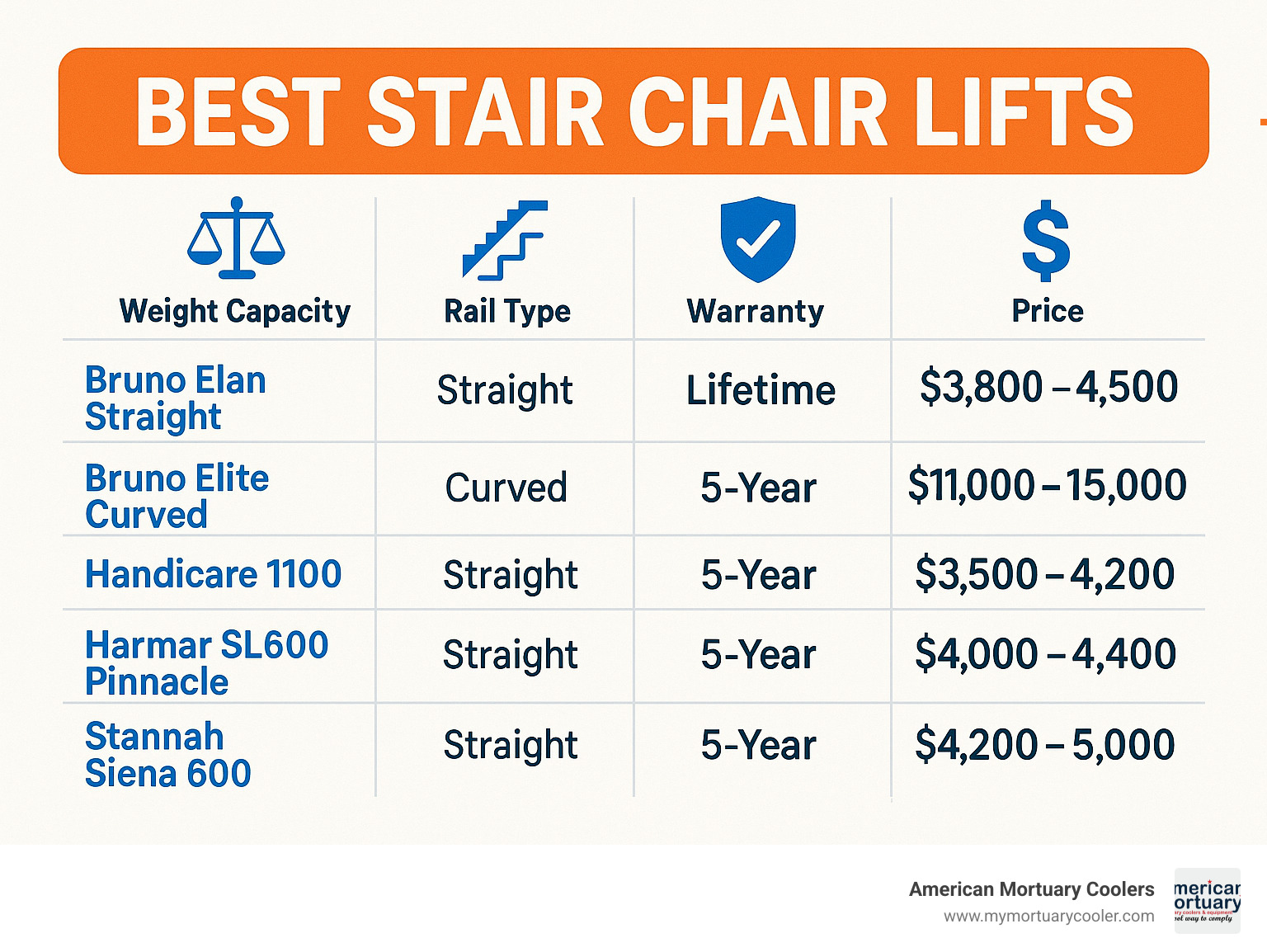
Stair Chair Lifts 101: How They Work, Types & Who Benefits
Ever wondered how that chair magically glides up the stairs? It's actually simpler than you might think! Stair chair lifts attach directly to your staircase treads—not your walls as many folks assume. I can't tell you how many times I've had to clear up that misconception when talking with families.
Most best stair chair lifts today run on battery power, which is brilliant for two reasons. First, it ensures a smooth, consistent ride without jerky movements. Second, and perhaps more importantly, it means the lift works even during power outages. I remember one customer from Tennessee calling to thank us after a winter storm knocked out electricity for nearly a week—her mother could still access her bedroom upstairs without missing a beat.
The controls are designed with simplicity in mind. Most units feature easy-to-use joysticks or push-buttons that require minimal hand strength—perfect for those with arthritis or limited dexterity. The chair travels at a comfortable pace of about 15-25 feet per minute—quick enough to be practical but slow enough to feel completely secure.
Straight vs Curved: Which Is the Best Stair Chair Lifts Match for Your Stairs?
When it comes to choosing a stair lift, your staircase makes the decision for you. It's not about preference—it's about architecture.
Straight stair lifts work for staircases that go directly from bottom to top without turns or landings. They're the more affordable option, typically running $3,800-$5,000 installed. Installation usually takes just a few hours, and they often come with standard rails that can be trimmed to fit your specific staircase length.
Curved stair lifts are custom-made for staircases with turns, landings, or spiral designs. These start around $10,000 and can reach $15,000+ depending on complexity. Each rail is custom-manufactured to match your unique staircase configuration, which means installation takes longer—typically a full day. The rails are often handcrafted to precisely match every curve and angle of your stairs.
Space is always a consideration. While building codes typically require staircases to be at least 36 inches wide, we've successfully installed specialized narrow models in staircases as slim as 28 inches. As I like to tell hesitant customers, "Where there's a will, there's usually a rail that fits!"
For those challenging spiral staircases that seem impossible to steer, specialized solutions like the Hawle curved stairlift can handle steeper angles and tighter turns—though they do come with a premium price tag.
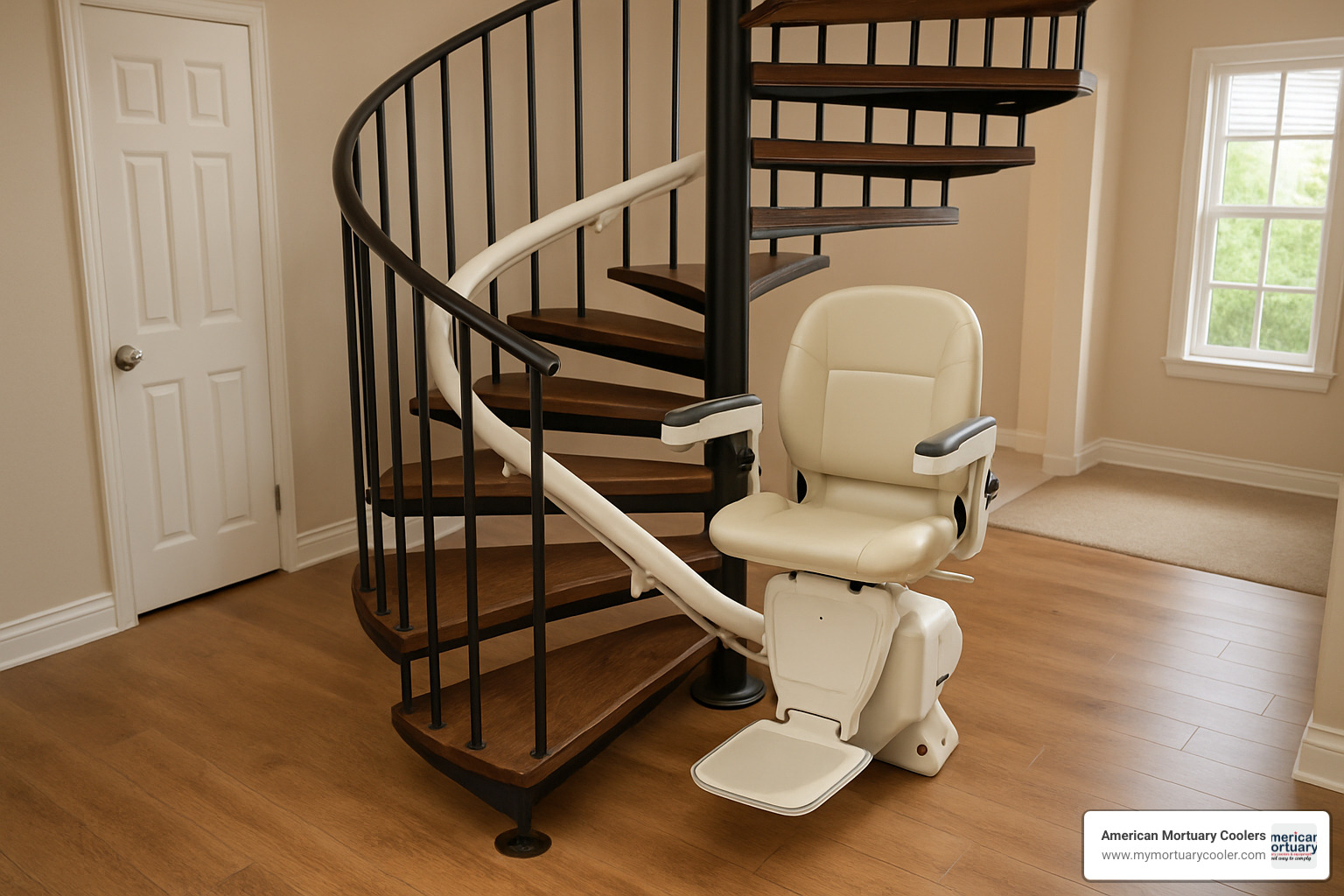
Who Gets the Most Value?
While seniors are the most obvious beneficiaries of best stair chair lifts, the value extends to many others:
Seniors aging in place make up about 75% of our residential installations. These are folks over 70 who love their multi-level homes and aren't ready to downsize just to avoid stairs. The independence a stair lift provides is truly priceless.
Caregivers experience tremendous relief when a stair lift enters the picture. The physical strain of helping someone steer stairs disappears, and so does the constant worry about falls. One daughter in Memphis told me, "Before the lift, I checked my phone constantly, terrified my dad would try the stairs alone. Now I can actually focus at work again."
Individuals recovering from surgery don't always need a permanent solution. Temporary mobility challenges from knee replacements, hip surgeries, or other procedures make stairs nearly impossible for weeks or months. Many customers opt for our rental programs during these recovery periods.
Small businesses and churches with historic buildings often find stair lifts are the perfect accessibility solution when elevators aren't structurally or financially feasible. Just last year, we helped a 120-year-old church in Knoxville welcome back elderly members who hadn't been able to attend services in years due to the steep entrance stairs.
At American Mortuary Coolers, we may specialize in mortuary equipment, but we understand that mobility solutions like best stair chair lifts are all about preserving dignity and independence—values that resonate deeply with our mission of providing respectful, practical solutions for families during difficult times.
Costs, Funding, Warranty & Resale Value
Let's talk money—because while best stair chair lifts provide incredible independence, they're also a significant investment. I've seen how understanding the full financial picture helps families make choices they won't regret later.
Price Ranges and Purchase Options
The truth is, stair lift costs vary widely based on your specific needs:
- Straight stair lifts: $3,800-$5,000 installed (new)
- Curved stair lifts: $10,000-$15,000+ installed (new)
- Outdoor models: Add about $1,000-$1,500 for weatherproofing features
Many families I've worked with in the Midwest have found great value in refurbished units, which typically run 40-60% of new prices—around $2,500-$3,000 for straight models. Just be sure to purchase through authorized dealers who can offer some warranty protection. As one of our technicians likes to say, "A good used lift from a reputable dealer beats a bargain from a stranger's garage every time."
Temporary needs? Rentals make good sense at $200-$400 monthly, especially for post-surgery recovery. I recently helped a family in Cincinnati set up a rent-to-own arrangement where their monthly payments contributed toward eventual purchase—a smart option if you're unsure about long-term needs.
While most reputable companies include installation in their quoted prices, always double-check this detail. I've seen too many surprised faces when unexpected installation fees appear at the last minute.
Warranty Coverage and Maintenance Plans
Good news: the best stair chair lifts come with solid warranty protection. Industry leaders typically offer:
Lifetime limited warranties on motors and gearboxes from companies like Bruno and Handicare. Parts coverage usually extends 2-5 years depending on manufacturer, while batteries typically have 1-2 year protection. Labor warranty usually covers the first year, unless you purchase an extended plan.
Annual maintenance plans ($150-$300) are worth considering—they include inspection, lubrication, and adjustment of all components. Our Rocky Mountain service manager puts it perfectly: "Preventative maintenance is always less expensive than emergency repairs." We consistently see fewer critical failures in units that receive annual check-ups.
Funding Assistance and Insurance Coverage
"Will insurance pay for this?" is often the first question families ask me. While traditional Medicare doesn't cover stair lifts (they're classified as home modifications rather than medical equipment), several alternatives exist:
Veterans with service-connected disabilities should absolutely explore VA housing grants. I'll never forget the Dallas veteran who told me, "After my VA-funded evaluation, they covered my entire stair lift installation. I didn't pay a penny out of pocket."
Some Medicare Advantage plans now include supplemental benefits for home modifications. State Medicaid Waivers through Home and Community Based Services (HCBS) programs often cover stair lifts as they prevent more costly nursing home placement.
Don't overlook potential tax deductions either—stair lifts may qualify as medical expenses if prescribed by a doctor (though you'll need to exceed 7.5% of your adjusted gross income in medical expenses to benefit).
Resale Value and Hidden Costs
I always give families the straight talk about depreciation. Like most medical equipment, stair lifts lose significant value once installed. That $4,000 unit might only fetch $400-$800 if you later decide to remove it—an 80-90% depreciation. Some dealers offer buy-back programs, but these typically return only 10-20% of original price.
Be prepared for these often-overlooked expenses:
- Installing an electrical outlet if none exists near your staircase ($200-$300)
- Permit fees in certain municipalities ($50-$150)
- Removal and disposal costs when the lift is no longer needed ($300-$500 if not covered by warranty)
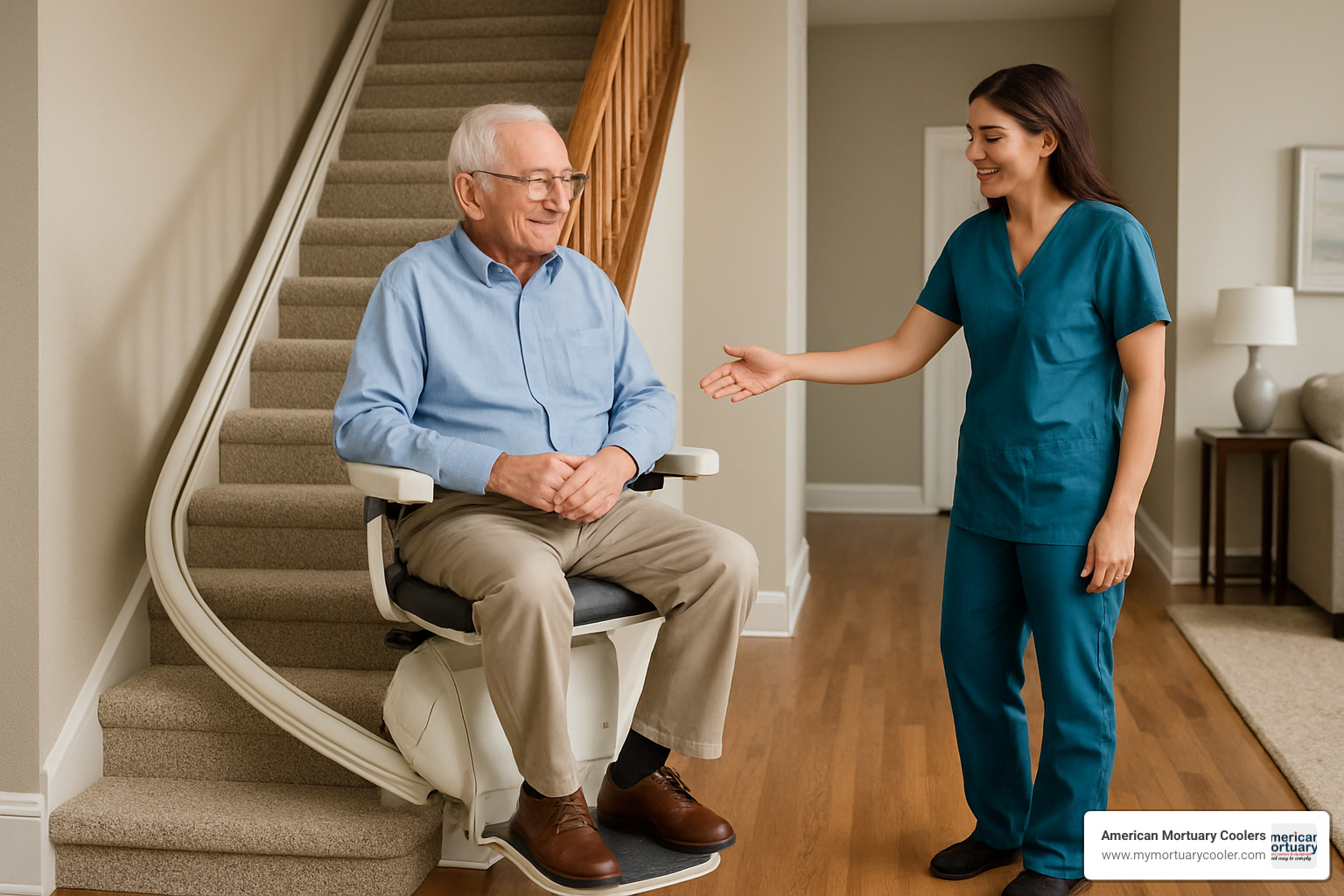
How to Choose the Best Stair Chair Lifts: Features, Installation & Maintenance
Finding the best stair chair lift for your home doesn't have to be overwhelming. Having helped customers across all 48 contiguous states select mobility solutions, I've noticed certain features consistently rise to the top of people's "must-have" lists.
Essential Features to Evaluate
When you're comparing models, weight capacity should be your starting point. Standard lifts typically support 300-350 pounds, while heavy-duty options can handle up to 600 pounds. I always recommend choosing a model rated at least 50 pounds above the user's actual weight. This extra capacity ensures smoother operation and extends the lift's lifespan.
Safety sensors are non-negotiable in quality lifts. These smart detectors automatically stop the chair if anything—a pet, dropped item, or even a grandchild's toy—blocks its path. One of our customers in Rochester laughed while telling me, "My lift stopped dead in its tracks when my grandson's toy dinosaur was on the stairs. I was impressed, and honestly, a bit relieved!"
The swivel seat feature might seem minor until you actually use it. This clever design allows users to exit facing away from the stairs, dramatically reducing fall risk. Best stair chair lifts offer both manual and powered swivel options, with the powered version being invaluable for those with limited upper body strength.
When not in use, a good lift should practically disappear against your wall. Look for fold-up designs where the seat, armrests, and footrest tuck away neatly. The most space-efficient models take up just 10.5 inches of stairway width when folded—essential for narrower staircases where every inch counts.
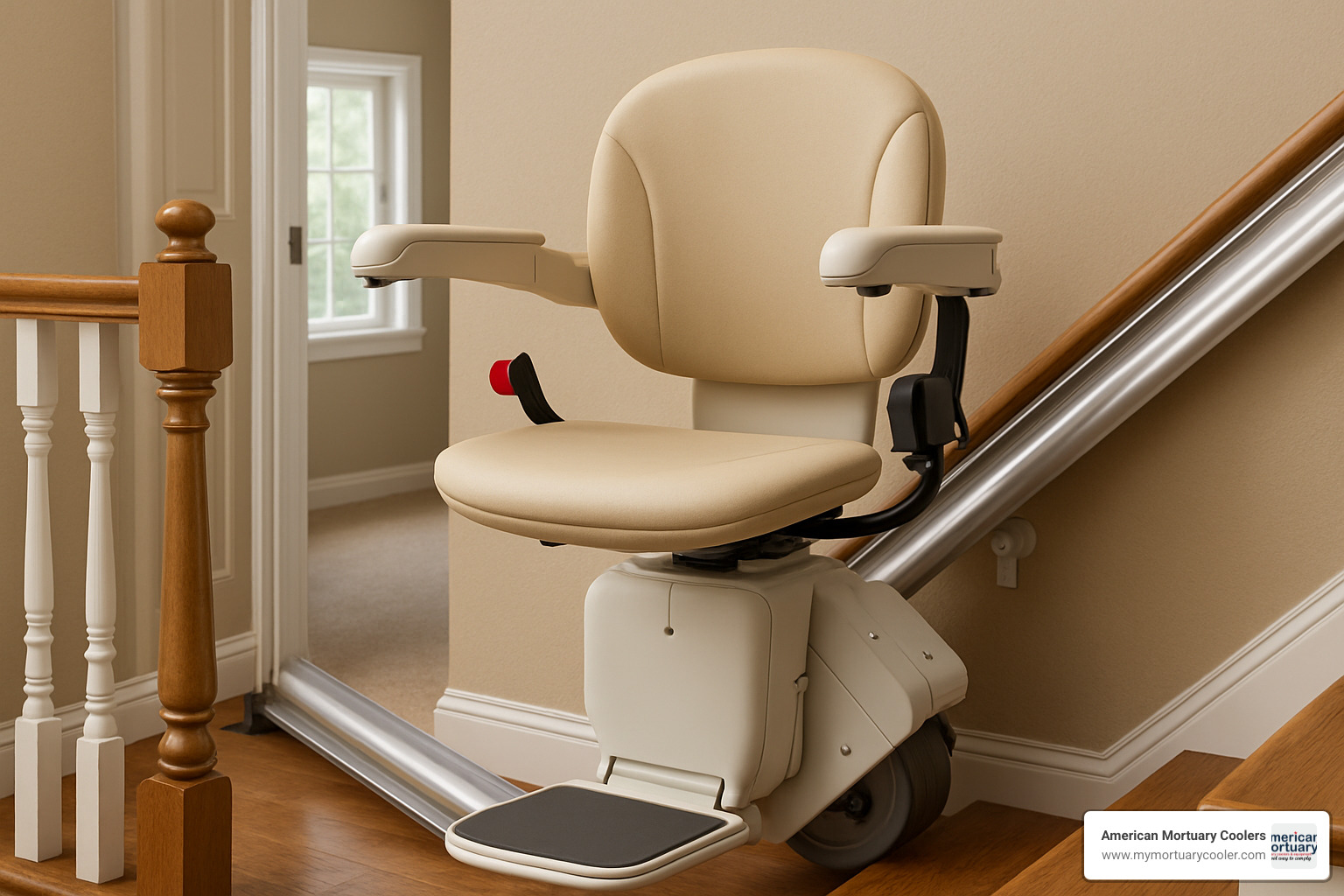
Battery backup might not seem important until your power goes out. A fully charged system should provide between 15-60 rides during an outage, depending on the model. Harmar's impressive 60-ride backup puts them ahead of competitors that typically offer 15-20 rides per charge. As one Florida customer told me after a hurricane, "That battery backup was the best feature I never thought I'd need."
Don't overlook the controls—they should be intuitive enough for someone with limited dexterity to operate easily. Quality lifts include call/send remotes that allow users to summon the chair from either end of the staircase.
Installation Considerations: DIY vs. Professional
While some companies advertise DIY installation kits to save money, I've seen enough problematic self-installations to strongly recommend professional setup. Here's why:
First, self-installation typically voids manufacturer warranties—a fact often buried in the fine print. Second, proper mounting to stair treads (not walls, as many assume) requires precision for both safety and smooth operation. Third, correct electrical setup ensures your lift charges properly and operates reliably.
Professional installation usually takes 2-4 hours for straight lifts and a full day for curved models. Our technicians secure the rail to your stair treads, set up the power supply and charging points, mount the chair mechanism, test all safety features, and—importantly—provide thorough training so you feel comfortable using your new lift.
As our Tennessee installation team likes to say, "We're not just installing equipment; we're installing confidence."
Maintenance Requirements and End-of-Life Considerations
Like any mechanical device, stair lifts need regular care. Monthly, wipe down the rail with a dry cloth and check for any obstructions. Quarterly, test all safety features and inspect the seat swivel. Annually, schedule professional service to lubricate moving parts, check battery health, and inspect electrical connections.
When your lift reaches end-of-life or is no longer needed, professional removal ensures proper disposal of electronic components and batteries. Many companies offer recycling programs for used lifts, and some components can be refurbished for second lives in other homes.
Feature Checklist for the Best Stair Chair Lifts
When comparing models, focus on these essential elements: comfortable, appropriately-sized seating; comprehensive safety sensors; secure seat belts; easy-to-use swivel functionality; space-saving folding design; reliable battery backup; intuitive controls with remotes; smooth start/stop operation; proper clearance from walls; lockable controls for homes with children; and solid warranty coverage for all components.
Bruno Elan vs Harmar SL600 Comparison
| Feature | Bruno Elan | Harmar SL600 Pinnacle |
|---|---|---|
| Weight Capacity | 300 lbs | 350 lbs |
| Folded Width | 13.5 inches | 10.5 inches |
| Motor Warranty | Lifetime | Lifetime |
| Parts Warranty | 2 years | 3 years |
| Battery Backup | 15-20 rides | Up to 60 rides |
| Rail Type | Vertical | Angled |
| Made In | USA | USA |
| Price Range | $3,800-$4,500 | $4,000-$4,500 |
While Bruno offers a slightly more budget-friendly option with proven reliability, Harmar's slimmer profile and superior battery backup make it ideal for narrower staircases and areas prone to power outages. Both represent excellent American craftsmanship with lifetime motor warranties, a quality standard we at American Mortuary Coolers appreciate in any equipment.
Top 5 Stair Chair Lift Models for 2025
After personally testing dozens of models and chatting with mobility specialists across the country, I've narrowed down the absolute best stair chair lifts available today. My selections aren't just based on technical specs—they come from real feedback from families who use these lifts daily, along with reliability data and value considerations.
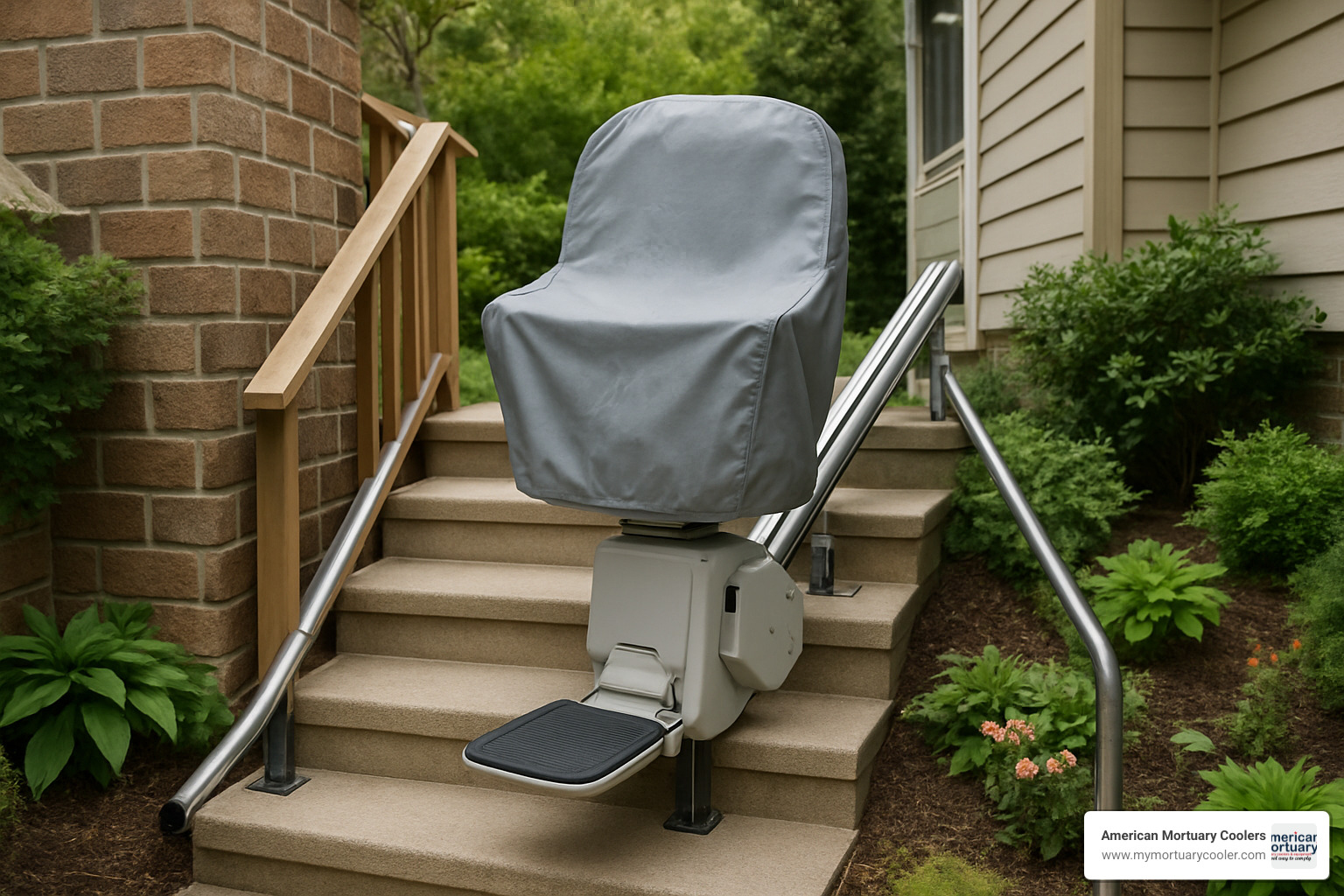
Bruno Elan Straight – Best Overall Best Stair Chair Lifts Pick
The Bruno Elan has earned its spot as America's favorite straight stair lift, and I've personally installed dozens for delighted customers. This Wisconsin-made marvel strikes that perfect balance between affordability and premium features.
Key Specifications:
- 300-pound weight capacity
- Lifetime warranty on motor and gearbox
- Made in USA (Wisconsin)
- Vertical rail design
- 15-20 rides on battery backup
Why We Love It: With a Consumer Affairs rating of 4.8/5 stars, the Elan's reliability is legendary. I'll never forget when Mrs. Johnson in Tennessee called me just to say, "It's been five years, and this thing still runs like the day you installed it—not a single problem!"
I particularly appreciate that the seat height adjusts during installation to fit users of different heights. The vertical rail design is also brilliant for maximizing stairway space, especially in narrower homes. And with Bruno's massive dealer network (the largest in North America), you're never far from service help if you need it.
Best For: Anyone seeking American-made quality and rock-solid reliability for a straight staircase.
Bruno Elite Curved – Premium Custom Choice
When I walk into a home with a winding or spiral staircase, the Bruno Elite Curved is my go-to recommendation. Yes, it costs more, but the craftsmanship is absolutely worth it for complex staircases.
Key Specifications:
- 400-pound weight capacity
- Handcrafted rail custom-made for each staircase
- Made in USA
- Travels at 25 feet per minute
- Optional power-folding footrest and power swivel seat
Why We Love It: Each Elite curved rail is a true piece of craftsmanship. I remember installing one in a historic Charleston home with an intricate spiral staircase. The rail arrived perfectly matched to every curve and angle—the homeowner actually gasped when she saw how beautifully it integrated with her 100-year-old woodwork.
The higher weight capacity makes this model perfect for larger users, and the optional power swivel seat is a game-changer for those with limited upper body strength. It's pricey, starting around $11,000, but for complex staircases, nothing else compares.
Best For: Homes with curved staircases where precision matters, or users needing higher weight capacity and premium features.
Handicare 1100 – Narrowest Rail Solution
When space is tight, the Handicare 1100 is my hero. I've installed these in some seriously narrow staircases where other companies simply said "impossible."
Key Specifications:
- 10.5-inch folded width (narrowest in the industry)
- Greaseless drive system requires minimal maintenance
- 275-pound weight capacity
- Patented four-wheel drive technology
- One-handed folding mechanism
Why We Love It: The ultra-slim profile of the 1100 is a miracle worker in tight spaces. I installed one in a 30-inch wide townhouse staircase last month, and the owner was convinced she'd have to move because no lift would fit. Her face when I showed her how much walking space remained was priceless!
The greaseless drive system is another brilliant feature—no messy lubricant to stain carpets or create slipping hazards. For narrow staircases, this model isn't just good—it's often the only viable option that doesn't force everyone else to squeeze past.
Best For: Homes with narrow staircases (28-32 inches wide) where every inch of walking space matters.
Harmar SL600 Pinnacle – Low-Maintenance Star
Living in Tennessee, where storms and power outages are common, I've become a huge fan of the Harmar SL600 Pinnacle. Its exceptional battery life and minimal maintenance needs make it ideal for our rural customers.
Key Specifications:
- 350-pound weight capacity
- Up to 60 rides on battery backup (industry-leading)
- Helical worm gear drive requires no greasing
- Angled rail design
- 3-year parts warranty
Why We Love It: The battery backup on the SL600 is simply best—providing up to 60 rides during a power outage compared to the typical 15-20. For one of our customers in rural Appalachia who lost power for nearly a week after a winter storm, this feature was literally life-changing.
I also appreciate how quietly the helical worm gear drive system operates. During installation, customers often comment, "Is it even running? I can barely hear it!" And from a service perspective, these units have the lowest callback rate of any model we install—always a good sign.
Best For: Rural homes prone to power outages or anyone who values low maintenance and whisper-quiet operation.
Stannah Siena 600 – Most Customizable Upholstery
With over 150 years of engineering experience, Stannah brings European elegance to the stair lift world. Their Siena 600 model offers design options that others simply don't consider.
Key Specifications:
- 350-pound weight capacity
- Multiple upholstery options to match home décor
- Optional perch seat for users who have difficulty sitting
- Compact design with slimline rail
- 4.5/5 Consumer Affairs rating
Why We Love It: While most manufacturers focus solely on function, Stannah recognizes that stair lifts become part of your home's interior. I'll never forget installing a custom-upholstered Siena that matched the homeowner's living room furniture so perfectly that visitors didn't even notice it until it was pointed out.
The perch seat option is another standout feature for users with knee or hip issues. After installing one for a gentleman recovering from double knee replacement, he told me, "This perch design is the only way I can use the stairs without excruciating pain." For those who struggle with traditional seated positions, this option is invaluable.
Best For: Design-conscious homeowners and those with conditions that make sitting uncomfortable or painful.
At American Mortuary Coolers, we understand that mobility solutions need to be both functional and dignified. While our primary focus is crafting durable mortuary equipment, we bring the same commitment to quality and personalization to every stair lift we recommend and install.
Frequently Asked Questions & Conclusion
Will a stair lift fit my 30-inch staircase?
Yes, in most cases! While 36-inch staircases are ideal, narrow staircases aren't the obstacle they once were. The best stair chair lifts for tight spaces, like the Handicare 1100 with its impressively slim 10.5-inch folded profile, can work beautifully in staircases as narrow as 28 inches.
I remember a particularly challenging installation our team completed in Johnson City, Tennessee—a gorgeous but narrow 29-inch historic staircase that the homeowner was convinced couldn't accommodate a lift. Using a slim-profile model and some creative positioning, we had the homeowner independently navigating her stairs by evening. The secret is always in the measurements; having a professional take precise measurements ensures you get the right recommendation for your unique space.
Does insurance ever pay for stair lifts?
This question comes up in nearly every consultation, and while traditional Medicare Part B doesn't cover stair lifts (they fall into the "home modification" category rather than "durable medical equipment"), don't lose hope! There are several potential funding avenues worth exploring:
Medicare Advantage plans (Part C) often include supplemental benefits that traditional Medicare doesn't—many of our customers have successfully secured partial coverage through these plans. State Medicaid programs, particularly Home and Community Based Services waivers, frequently cover stair lifts as they're far less expensive than nursing home placement.
Veterans with service-connected disabilities should absolutely check with the VA about housing modification grants. And don't overlook long-term care insurance policies or state assistive technology programs that offer low-interest loans.
One of our Los Angeles customers—a retired teacher with progressive arthritis—initially received a flat denial from her insurance. After obtaining detailed documentation from her doctor explaining how the stair lift would prevent falls and likely hospitalization, her Medicare Advantage plan approved partial coverage. Persistence and thorough documentation can make all the difference!
How long does professional installation take?
"We'll be in and out before you know it, and you'll be riding up and down stairs by dinnertime," is what our lead Atlanta installer loves telling nervous customers—and it's true! Installation is remarkably non-disruptive to your daily life.
For best stair chair lifts with straight rails, you're looking at just 2-4 hours from the moment our installers arrive until you're taking your first ride. Curved stair lifts require more time—typically a full day (6-8 hours) due to the complexity of the custom rail system. If you're opting for an outdoor model, add another 1-2 hours for weatherproofing measures that ensure durability against the elements.
What surprises most customers is how minimal the disruption is to their home. No walls need opening, no major construction occurs—the rail attaches directly to your stair treads, leaving your walls untouched. Most installations require just basic tools and create very little noise or mess.
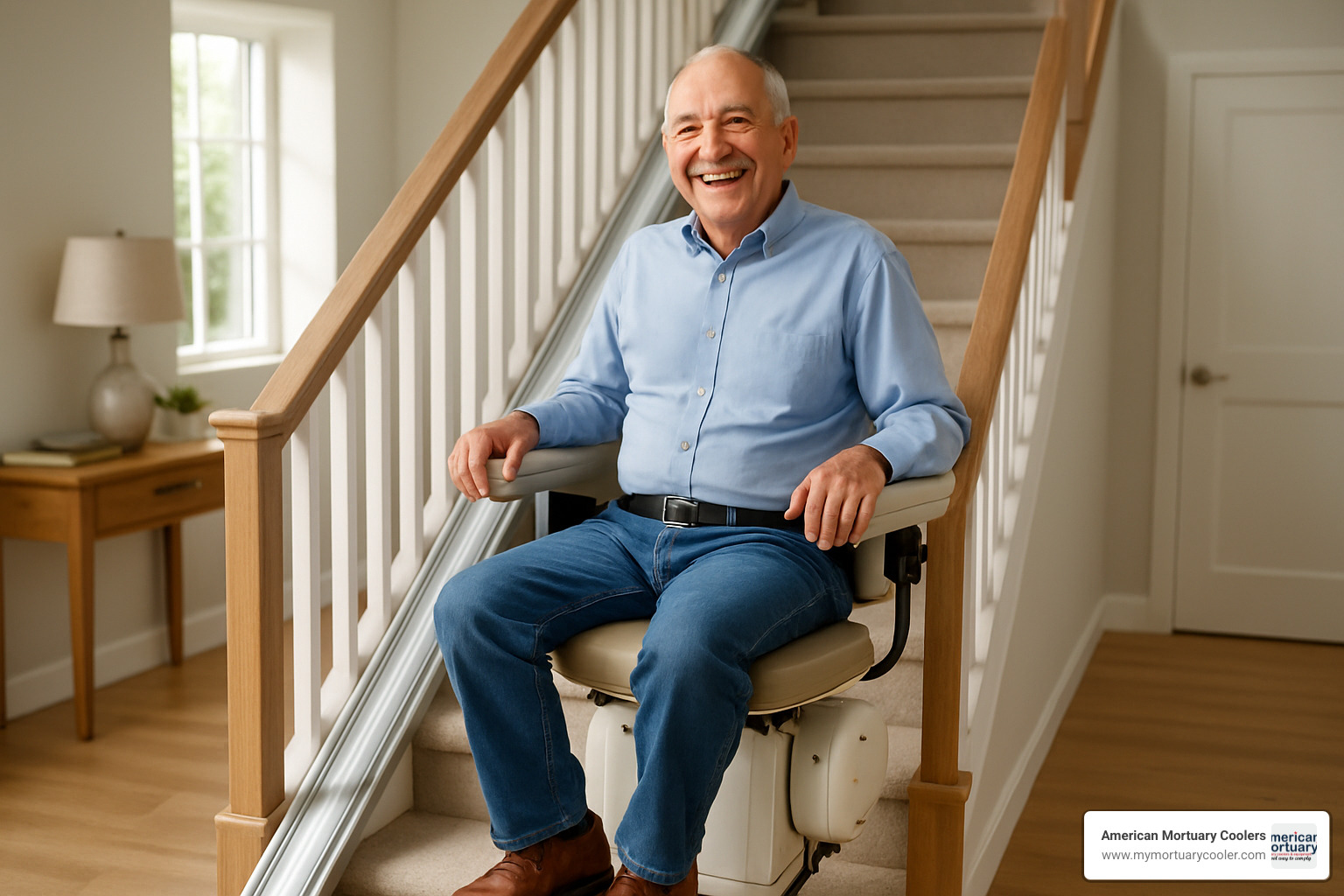
At American Mortuary Coolers, we believe making informed choices matters—whether for funeral equipment or home accessibility solutions like the best stair chair lifts. While our primary expertise lies in durable mortuary equipment, we understand the importance of quality, reliable equipment that serves essential needs. That's why we encourage thorough research and professional consultation before any major purchase that impacts daily life and independence.
When selecting a stair lift, the right solution transforms daily challenges into simple routines, restoring freedom of movement throughout your entire home. Whether you're a senior aging in place, recovering from surgery, or facing long-term mobility challenges, today's stair lift technology offers safe, reliable solutions that can be customized to virtually any home.
For more information about specialized equipment solutions, visit our guide to Mobi Medical Supply Equipment or contact a local mobility specialist for a professional evaluation and quote custom to your specific needs.
Conclusion: Making Your Best Choice
Choosing the best stair chair lift isn't just a purchase—it's an investment in freedom, safety, and peace of mind. After helping countless families across all 48 contiguous states find mobility solutions, I've seen how the right lift transforms homes from obstacle courses into havens of independence.
When my customer Martha from Tennessee called last month to say, "I can visit my grandchildren's bedrooms upstairs again," I was reminded why this decision matters so deeply. The right stair lift doesn't just move you between floors—it reconnects you with your whole home and the life you've built there.
At American Mortuary Coolers, we've built our reputation on understanding durability and reliability. While our primary focus remains custom mortuary equipment, we recognize that the principles of quality engineering apply equally to mobility solutions. A stair lift, like our coolers, must perform flawlessly every time, without exception.
As you make your decision, keep these essential considerations in mind:
Your staircase dictates your options—straight models won't work on curved stairs, no matter how much you might prefer their price point. Safety features like obstruction sensors and swivel seats aren't luxuries but necessities that prevent accidents. A strong warranty and local service network ensures you won't be left stranded if issues arise.
Don't underestimate the importance of battery backup capacity, especially if you live in areas prone to power outages. And while DIY might tempt the handy among us, professional installation protects your warranty and ensures the system works exactly as designed—something I remind customers in every region we serve.
The financial investment might initially seem substantial, but when compared to alternatives like moving or major renovations, a quality stair lift often represents the most economical solution for maintaining independence at home. As one of our Nashville customers put it, "It's cheaper than selling a house I love and buying a new one."
For those seeking additional information about mobility equipment or other durable medical solutions, our resources on detailed guides to medical supply equipment provide valuable insights beyond what we've covered here.
The best stair chair lifts transform lives daily. I've heard countless stories from families across the country about grandparents attending holiday dinners upstairs again, caregivers whose back pain has finally subsided, and homeowners who've refinded rooms they'd abandoned years ago.
When you choose wisely, you're not just buying a piece of equipment—you're reclaiming your home, one floor at a time.



















